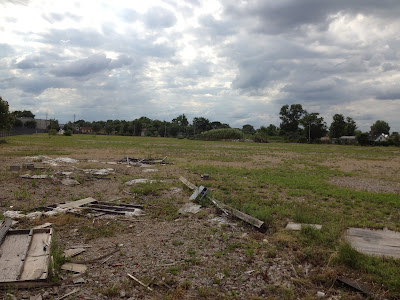Cigarette maker Philip Morris closed its production operations in Louisville in 1999. After more than a decade of disrepair and abandonment, the city has decided to raze the final remaining structures on the site. Updated 10/24/13 with more photos.
 |
| Aerial photo of site, before demolition began. Locations annotated by coloured arrows. |
Guard station at the main entrance for the former plant, located on the corner of Broadway and Dixie Highway. The main production building was in the now empty field behind the gate. This is the red arrow on the aerial map.
Ruins and residue of the former plant. After closing the plant, Philip Morris donated the land and structures to the city of Louisville. A former employee told me that these buildings were probably beyond re-purposing, due to the decay and materials located within them.
The interior of the guard station is just as was left when the plant closed: Coffee cups still on the counter, books waiting to be read the guard on the next shift.
Note the Philip Morris ledger book on the counter, along with the clipboard and ashtray.
1990 called. It would like to have its office chairs kindly returned. Please. Thank you...
Across Dixie Highway is another building, still apparently untouched. It appears to be a management or admin structure. This is the blue arrow on the aerial view.
 |
| Same location, several months later. |
 |
| Closeup of the building on the right. Visitors would apparently check in here. |
 |
| Facade, sans building. |
 |
| Yea, that stings. |
Meanwhile next-door, a warehouse building is being leveled with a wrecking ball. This is where the YMCA will be located. After some deliberation, the city decided that this building couldn't be saved. Note the water container on the upper floor, part of the fire suppression sprinkler system.
Formerly the receiving building, materials would be transferred from this structure to the actual production plant across the street.
Trucking docks were located out in the front along Broadway. View from green arrow.
A set of long disused rail lines lead to the rear of the building. Given that another structure is currently sitting on the tracks outside this frame, its safe to say that they haven't been used in decades. View from yellow arrow on aerial map.
 |
| Same angle, later on. They are grinding the bricks into dust. |
A lonely elevator shaft rising amidst the wreckage filling the soon-to-be-vacant lot. When doing a slow demolition such as this, the elevator shafts are the last to be torn down. This is due to their great strength and their ability to stabilize the building while its being leveled. Note the Brown-Foreman watertower in the background.
This old building, while largely useless for its original purpose, is actually full of valuable materials. Some boards, twenty feet in length, appear to be 4 inches thick and 16 inches wide. These massive old beams are quite valuable and difficult to obtain anymore, trees of this size long having been wiped out in this part of the country.
Likewise, these old bricks will be shipped out to live again somewhere else. Clay bricks like these simply aren't made anymore. In times past, they would've simply been dumped into a landfill.
 |
| Located to the south of the old factory is this nifty old brick alley. You don't see these too much anymore... |














These brought back memories. My dad worked there from 88 to the closing in 99 when he got transferred to the Richmond plant. I remember visiting the factory several times and even going to work with him on a number of occasions. I specially remember the wooden floors that held up the massive machinery in your one photo.
ReplyDeleteI had family employed at the plant as well in the 70s and 80s, second shift. My biggest memory is the of fake owls situated around the plant to scare off birds. Its all very strange to see it now.
ReplyDeleteI grew up just a couple of blocks from there, in the 60's & early 70's, when it was bustling. It was a landmark of the neighborhood, along with Brown Foreman and the towering whiskey bottle water tower. Hard to believe it's going to be a Walmart now.
ReplyDeletei worked at pm. 1962 to 1993 3rd shift good people.
ReplyDeleteAnonymous did you know Betty Jamison
ReplyDeleteMy mother and late stepfather worked there; her from the late 70's to '95 and him from the early 70s until 1995
ReplyDeleteShe worked in the plant taking the tobacco off the belts (or hooks?) and my stepfather was vice president of the union.
Verna Arrwood (Stewart later Smith then Cope) and my stepfather was Larry Stewart
Sad to see these scenes. Large portion of my life was spent there and at the Stemmery on Millers Lane in Shively. I started there in 1972, transferred to Maple Street in 1988, and was fortunate to take early retirement in 1999. PM paid off most of my schooling in early 90's & I worked in nursing after leaving PM for 18 years. PM was good place to work. Great before bunch of people. Good memories.
ReplyDelete